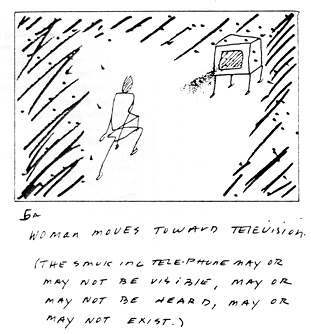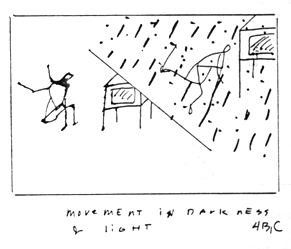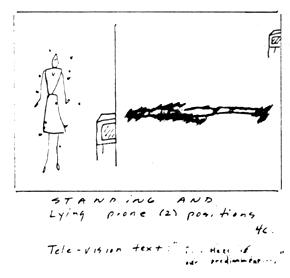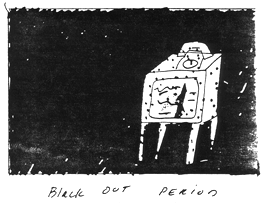
--from
Tele: A Narrative,
a collaboration between Elizabeth Lahey and Meredith Stricker![]()
![]() [ performance story board ]
[ performance story board ]
.
.
![]() Working Notes / Movement notes, Elizabeth Lahey:
Working Notes / Movement notes, Elizabeth Lahey:
from Tele, a collaboration with video, text, drawing and dance, first performed at Minor Injuries Gallery, New York, in 1986.
![]() Tele-; ( [Tele. OHG. Zâla = OE. taél fem. danger, snare, trap] 1. Evil speaking, detraction, calumny. 2. Deceit, enticement, allurement. --Oxford English Dictionary.)
Tele-; ( [Tele. OHG. Zâla = OE. taél fem. danger, snare, trap] 1. Evil speaking, detraction, calumny. 2. Deceit, enticement, allurement. --Oxford English Dictionary.)
![]() Tele-
began with a dream in which, instead of ringing, a telephone began to "smoke." In the dream, I answered, lifting the receiver thinking it was my friend "Will" calling. The voice on the other end identified itself as "an entity." After giving me a sort of grade card report of my abilities, the voice became garbled with static and a many-tongued incoherency--some part of the message was missing.
Tele-
began with a dream in which, instead of ringing, a telephone began to "smoke." In the dream, I answered, lifting the receiver thinking it was my friend "Will" calling. The voice on the other end identified itself as "an entity." After giving me a sort of grade card report of my abilities, the voice became garbled with static and a many-tongued incoherency--some part of the message was missing.
![]() Simultaneously, Meredith Stricker had sent me some notes on her research into the Eleusinian mysteries; [". . . then they entered the sacred precinct and the doors of the Telesterion. . . "](1) and ["the initiated must not be informed, but they must receive impressions, and they must be put into a certain attitude of mind, provided it be evident they be prepared for it."] (2) Along with these notes were drawings she had made of what she described as an "Orpheus Box." Here she was sending ideas for boxes on a stage. (The boxes were detailed as "old televisions with mirrors in them and objects such as cones and drawings. . . ."). The term "T.V. obsession" was written on the corner of these sketches.
Simultaneously, Meredith Stricker had sent me some notes on her research into the Eleusinian mysteries; [". . . then they entered the sacred precinct and the doors of the Telesterion. . . "](1) and ["the initiated must not be informed, but they must receive impressions, and they must be put into a certain attitude of mind, provided it be evident they be prepared for it."] (2) Along with these notes were drawings she had made of what she described as an "Orpheus Box." Here she was sending ideas for boxes on a stage. (The boxes were detailed as "old televisions with mirrors in them and objects such as cones and drawings. . . ."). The term "T.V. obsession" was written on the corner of these sketches.
![]() Acknowledging this powerful X-ing over between us, we began to track down and focus on the narrative cohering in our lives and set the structure for the performance.
Acknowledging this powerful X-ing over between us, we began to track down and focus on the narrative cohering in our lives and set the structure for the performance.



![]() The movement idea was to create a very singular intimacy--the kind of thought-feeling process which can manifest in any living room where one is alone with a "turned-on t.v." We were dealing with inexplicable atom exchange (static) and translating that signal into a flesh and blood, skin and bone realism, using the body to call attention to and reduce the seductiveness of death. The premise that the television is a nonstop commercial for the safety of nuclear war, by "proving" that the world (body/image) can be taken apart (turned off) and put back together neatly, in less time than it takes to change channels, became the rhythm of the performance--the dialogue between "increasing light" and "black out period." Again from Meredith's original notes: [". . . the fear of death was taken away by the mysteries. . . they affirmed, as did those of Orpheus, that our life is but a death and it is at the death of body that soul becomes free and is born."] (3)
The movement idea was to create a very singular intimacy--the kind of thought-feeling process which can manifest in any living room where one is alone with a "turned-on t.v." We were dealing with inexplicable atom exchange (static) and translating that signal into a flesh and blood, skin and bone realism, using the body to call attention to and reduce the seductiveness of death. The premise that the television is a nonstop commercial for the safety of nuclear war, by "proving" that the world (body/image) can be taken apart (turned off) and put back together neatly, in less time than it takes to change channels, became the rhythm of the performance--the dialogue between "increasing light" and "black out period." Again from Meredith's original notes: [". . . the fear of death was taken away by the mysteries. . . they affirmed, as did those of Orpheus, that our life is but a death and it is at the death of body that soul becomes free and is born."] (3)
![]() In preparing these notes for HOW(ever),
I returned once more to the O.E.D., where I found in summary, Telesm Gr. [missing text] completion, performance, religious rite; later a consecrated object endowed with a magical virtue to avert evil; from [missing text] to complete, fulfil, perform (rites), officiate (in the mysteries), consecrate, from [missing text] end] = Talisman 1. a statue set up or an object buried under a pillar or the like to preserve the community, house, etc. from danger.
In preparing these notes for HOW(ever),
I returned once more to the O.E.D., where I found in summary, Telesm Gr. [missing text] completion, performance, religious rite; later a consecrated object endowed with a magical virtue to avert evil; from [missing text] to complete, fulfil, perform (rites), officiate (in the mysteries), consecrate, from [missing text] end] = Talisman 1. a statue set up or an object buried under a pillar or the like to preserve the community, house, etc. from danger.
Acknowledgements:
- The Mysteries of Eleusis, George Méautis; Theosophical Publishing House. India, 1932.
- Aristotle (reference not quoted)
-
L'ane Hellénique d'Aprés les Vases Grecs.
Elizabeth Lahey has collaborated on performance and visual/text projects with poet Meredith Stricker (via the U. S. Mail), since 1980. She lives and works in New York City.
go to this issue's table of contents